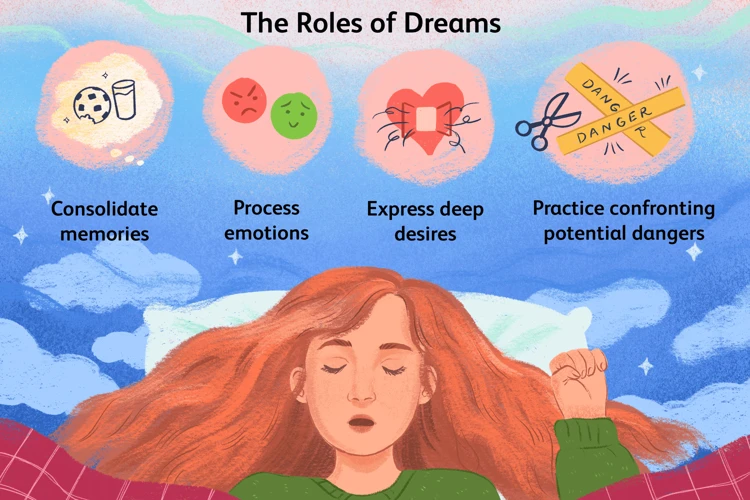Dreams have long fascinated and perplexed humans, as we delve into the recesses of our unconscious minds. They offer a gateway to explore our deepest desires, fears, and emotions, providing valuable insights into our psyche. One powerful tool for unraveling the mysteries of our dreams is through journaling. By recording our dreams and analyzing them with a curious and open mind, we can uncover the hidden meanings and symbols behind the stories that unfold while we sleep. In this article, we will guide you step-by-step through the process of dream journaling, sharing techniques and tips to help you unlock the secrets of your subconscious mind.
The Power of Dream Journaling

Dream journaling holds immense power in unraveling the enigmatic world of our dreams. By recording our dreams and analyzing them later, we create a bridge between our conscious and unconscious minds, allowing us to gain a deeper understanding of ourselves. The act of writing down our dreams helps solidify them in our memory and allows us to revisit them with clarity. Dream journaling also helps us notice recurring symbols and patterns, which are key to unlocking the hidden meaning behind our dreams. It serves as a personal archive that enables us to refer back to previous dreams and identify connections and themes that may transcend time. Keeping a dream journal enhances our self-awareness and introspection, as it invites us to explore our emotions, thoughts, and experiences within the dreamscapes we traverse. Whether you’re a novice or a seasoned dream explorer, the power of dream journaling is undeniable. It serves as a foundational tool for anyone seeking a deeper understanding of the subconscious mind and the mysteries that lie within our dreams. So, begin your journey today by starting and maintaining a dream journal that will become the key to unlocking the secrets of your inner world.
Getting Started: Creating Your Dream Journal

Creating your dream journal is the first step towards unlocking the hidden depths of your subconscious mind. The process begins with selecting a dedicated notebook or journal that you feel drawn to. Choose one that reflects your personality and inspires creativity. Keep your journal and pen or pencil by your bedside, ensuring easy access upon waking up from a dream. Develop a consistent habit of writing in your dream journal as soon as you wake up, before the details of your dreams fade away. It’s important to capture as much information as possible, including the emotions, symbols, characters, and any significant events or feelings experienced during the dream. Using specific dates and headers can help organize your entries and create a timeline of your dream journey. Additionally, consider using drawings or sketches to depict key elements of your dreams. This can further enhance your understanding and provide visual representations of your dreamscapes. Remember, your dream journal is a personal space for self-reflection, so feel free to experiment with different formats and styles that resonate with you. By creating and maintaining a dream journal, you lay the foundation for a deeper exploration of your dreams and their significance in your life. So, start your dream journal today and embark on a transformative journey of self-discovery.
Analyzing Symbols and Themes

Analyzing symbols and themes is a crucial aspect of understanding the deeper meanings within our dreams. By paying attention to recurring symbols, we can unravel the messages hidden in our subconscious mind. One effective approach to analyzing dream symbols is to create a visual representation, such as a table or list, where you can jot down recurring symbols and the associated emotions or experiences that come to mind. This visual aid allows for easy comparison and identification of patterns. Additionally, exploring personal and universal archetypes can provide valuable insights into our dreams. Archetypes, such as the hero, the shadow, or the wise old man, have universal symbolism that can help us understand the underlying themes in our dreams. Identifying common themes or patterns across different dreams further enhances our understanding of our subconscious. By recognizing recurring themes, we can gain a deeper understanding of unresolved emotions, anxieties, or desires that may be influencing our dream narratives. So, when delving into dream analysis, remember to document symbols, explore archetypes, and identify themes to decode the messages hidden within your dreams.
1. Pay Attention to Recurring Symbols
Recurring symbols in dreams are like signposts from our subconscious mind, beckoning us to pay attention and uncover their significance. When analyzing your dreams, it is crucial to identify and take note of any symbols that appear frequently. These symbols can vary widely from person to person, ranging from common objects to abstract concepts or even specific people. By recognizing and documenting these recurring symbols in your dream journal, you can start to piece together their meanings and decipher the messages your subconscious is trying to convey. The repetition of symbols in your dreams may indicate deep-rooted emotions, unresolved conflicts, or important themes that need your attention in waking life. Additionally, some symbols may have personal significance to you, while others may have universal meanings. To assist in your analysis, you can refer to /symbols-patterns-dream-journaling/ for comprehensive resources on dream symbols and their interpretations. By exploring the recurring symbols in your dreams, you can gain valuable insights into the inner workings of your mind and uncover the hidden layers of meaning in your dreamscapes.
2. Explore Personal and Universal Archetypes
When analyzing your dreams through journaling, it is essential to explore both personal and universal archetypes. Archetypes are recurrent symbols or themes that hold collective meaning across cultures and individuals. They tap into our collective unconscious and provide valuable insights into our own psyche and the human experience as a whole. Personal archetypes refer to symbols and themes that are unique to you, representing the specific aspects of your life, personality, or experiences. These could be specific objects, people, or even situations that hold significant meaning to you personally. By identifying and reflecting on these personal archetypes, you can gain a deeper understanding of your subconscious desires, fears, and unresolved conflicts. Universal archetypes, on the other hand, are symbols and themes that are recognized across cultures and have deep-rooted meanings. These archetypes include the hero, the mentor, the trickster, and many others. Exploring these archetypes within your dreams can provide insights into universal human experiences and the collective symbolism that shapes our dreams. By recognizing and analyzing both personal and universal archetypes, you can uncover hidden layers of meaning within your dreams and gain a broader understanding of yourself and the human condition. So, as you continue your journey with dream journaling, be attentive to these archetypes that emerge in your dreams and delve into their profound significance. They are the keys that unlock the doors to the depths of your unconscious mind.
3. Identify Common Themes or Patterns
Identifying common themes or patterns in your dreams is a crucial step in unraveling the hidden messages within them. As you review your dream journal entries, pay close attention to recurring elements or motifs that appear across different dreams. This could be a recurring setting, such as a specific location or environment, or it could be recurring symbols, like water or animals. By identifying these common themes or patterns, you can start to piece together the underlying meaning and symbolism behind them. One way to organize and analyze these patterns is by creating a table or list in your dream journal. For example, create columns for recurring symbols, emotions, and themes, and then fill in the corresponding details for each dream. This visual representation can help you spot connections and similarities that may not be obvious at first glance. You may also find it helpful to cross-reference your findings with resources on dream symbols and patterns. Remember, the process of identifying common themes or patterns requires patience and a willingness to dig deeper into the layers of your dreams. It is through this exploration that you will gain valuable insights into your subconscious mind and the messages it is trying to convey.
Interpreting Emotions and Feelings

Emotions and feelings play a pivotal role in our dreams, acting as a window into our subconscious mind. Interpreting these emotions can provide valuable insights into our innermost thoughts, fears, and desires. When journaling about your dreams, take note of your emotional state upon waking up. Pay attention to the intensity of emotions experienced within the dream itself. Are you feeling happy, sad, anxious, or excited? Understanding and analyzing these emotional nuances can help unravel the underlying messages of your dreams. By linking the emotions in your dreams to your waking life experiences and thoughts, you can gain a deeper understanding of the connections between your conscious and unconscious mind. Journaling serves as a powerful tool in this exploration, allowing you to document and reflect on the emotional landscape of your dreams over time. So, as you embark on your dream journaling journey, remember to delve into the realm of emotions and feelings, unlocking a wealth of insights into your inner self.
1. Note Your Emotional State upon Waking Up
When you wake up from a dream, it’s crucial to take note of your emotional state as it provides valuable insights into the meaning of your dream. Your emotions upon waking can range from excitement and happiness to fear and anxiety, and everything in between. By jotting down your initial feelings, you capture the raw essence of the dream experience. Create a table or list in your dream journal, with categories such as “Joy, Fear, Sadness, Confusion, etc.,” to categorize your emotional states. Take a few moments to reflect on the intensity and quality of your emotions. Were you overwhelmed with fear or just mildly uneasy? Did you wake up feeling elated or mildly content? Documenting these emotions will help you establish a baseline for analyzing the emotional landscape of your dreams. Over time, you may start to notice patterns between certain emotions and specific dream scenarios or symbols. This self-reflection exercise is an integral part of dream journaling, allowing you to delve deeper into the rich tapestry of your subconscious mind. Remember, as you embark on your dream journaling journey, you can always refer back to your initial emotions as you explore different approaches to dream journaling.
2. Analyze the Intensity of Emotions in the Dream
When analyzing the intensity of emotions in your dreams, it is crucial to pay attention to the range and intensity of feelings experienced. Emotions play a significant role in dreams and can provide valuable insights into our subconscious mind. Start by identifying the dominant emotion or emotions you felt during the dream. Was it fear, joy, sadness, anger, confusion, or a mix of emotions? Reflect on the intensity of these emotions and note whether they were heightened compared to your waking experiences. Strong emotions in dreams often indicate unresolved issues, repressed emotions, or unexpressed desires. For example, a dream filled with intense fear may indicate underlying anxieties or unresolved traumas. On the other hand, a dream brimming with joy and happiness may signify a sense of fulfillment or contentment in your waking life. By analyzing the intensity of emotions in your dreams, you gain a deeper understanding of your inner world and can further explore and interpret the underlying meaning behind these emotions.
Unraveling the Narrative: Storyline and Characters

In the realm of dreams, narratives unfold and characters emerge, offering valuable insights into our subconscious mind. Unraveling the narrative and understanding the significance of dream characters can provide profound revelations about ourselves and our inner struggles. To decipher the storyline of a dream, outline the plot and sequence of events. Take note of any symbols or themes that recur throughout the dream, as they may hold significant meaning. Additionally, delve into the significance of the dream characters themselves. Analyze their traits, actions, and interactions, and consider how they may represent different aspects of your psyche or unresolved conflicts. Reflecting on the relationships between characters can offer further clarity and understanding. By unraveling the narrative and examining the roles of dream characters, we can gain valuable insights into our subconscious desires, fears, and conflicts, enhancing our self-awareness and personal growth. So, continue to explore the depths of your dreams and incorporate these techniques into your dream journaling practice (link) for a richer understanding of your inner world.
1. Outline the Plot and Sequence of Events
When analyzing our dreams, it is essential to outline the plot and sequence of events that unfold within them. This allows us to gain a clearer understanding of the narrative and identify any underlying messages or themes. One approach to outlining the plot and sequence of events is to create a chronological timeline. This can be done using either a table or a list, depending on your preferred method of organization.
If you choose to use a table, you can create columns for the key elements of the dream, such as the setting, characters, and major events. In each row, record the relevant details as they occurred in the dream, providing a visual representation of the dream’s structure and progression. This allows you to easily identify any patterns or significant moments that may hold deeper significance.
Alternatively, you can choose to use a list format. Start by listing the main events of the dream in chronological order. Each event can be described briefly or in more detail, depending on your preference. This approach lends itself well to a more linear representation of the dream’s storyline and can aid in identifying any sequential or cause-and-effect relationships between events.
Regardless of the method you choose, outlining the plot and sequence of events in your dream analysis provides a solid foundation for interpretation. It helps you identify the key elements of the dream’s narrative and allows you to delve deeper into the significance of each event. Take your time to carefully analyze each component and consider how they may relate to your waking life experiences and emotions. By doing so, you can uncover valuable insights into your subconscious mind and gain a better understanding of yourself.
2. Delve into the Significance of Dream Characters
When analyzing our dreams, it is crucial to delve into the significance of the dream characters. These characters often represent different aspects of ourselves or people we know in our waking life. By exploring their roles and interactions within the dream, we can gain valuable insights into our subconscious thoughts and emotions. Take note of the prominent characters in your dream and consider their qualities, actions, and relationships. Reflect on how these characters make you feel, whether they evoke positive or negative emotions, and what they might symbolize in your waking life. For example, a dream character that embodies authority may represent your inner sense of power or your perception of someone in a position of authority in your life. Similarly, a dream character that evokes fear or anxiety might signify unresolved fears or insecurities in your subconscious mind. By analyzing the significance of dream characters, we can unravel hidden aspects of ourselves and gain a deeper understanding of our emotions and relationships.
3. Consider the Relationships between Characters
When analyzing our dreams, it is essential to explore and consider the relationships between the characters that populate our dreamscapes. These relationships can provide valuable insights into the dynamics and connections within our own lives and subconscious minds. Take note of the roles and interactions between the dream characters. Are they familiar or unfamiliar? Are they supportive or antagonistic? By examining these relationships, we can begin to uncover underlying emotions and desires that may be influencing our dreams.
Sometimes, dream characters represent different aspects of ourselves. Pay attention to how you relate to each character. Are you interacting with them as a friend, an adversary, or a lover? This can offer clues about how you perceive and relate to these aspects within yourself. For example, if you dream of a confrontational relationship with a dream character, it may indicate unresolved inner conflicts or a need for assertiveness in your waking life.
Additionally, consider the relationships between dream characters and their relevance to your real-life relationships. Are there parallels between the roles, dynamics, or emotions in your dreams and those in your waking life? Exploring these connections can provide profound insights into your interpersonal relationships and can help shed light on unresolved issues or unspoken feelings.
Remember, the relationships between dream characters are not always literal representations of specific people in your life. They are symbolic and often represent different aspects of your own psyche. By delving into these relationships, you can gain a deeper understanding of yourself, your relationships, and the underlying forces at play in your waking and sleeping worlds.
The Influence of Your Daily Life

Our dreams are not isolated occurrences but are deeply intertwined with our daily lives. The experiences, thoughts, and emotions that we encounter during our waking hours shape the content and messages of our dreams. By making connections between our dreams and our daily life, we can gain invaluable insight into our subconscious mind. One way to analyze the influence of daily life on our dreams is to reflect upon the experiences and thoughts that might have triggered specific dream themes or symbols. Identify any stressors or preoccupations that have captured your attention recently, as these may manifest in your dreams as well. By recognizing the interconnectedness between our waking and dreaming selves, we can achieve a greater understanding of our own psyche and the subconscious forces at play. So, take a moment to connect the dots between your daily experiences and your dreamscapes, and uncover the hidden layers of meaning that lie beneath the surface.
1. Connect Your Dreams to Experiences and Thoughts
When analyzing your dreams, it’s crucial to connect them to your experiences and thoughts in waking life. This step allows you to explore the potential connections between your subconscious mind and your conscious reality. One approach to making these connections is to list specific experiences or events from your daily life that may have influenced your dreams. Look for any similarities or themes that stand out. For example, if you had a stressful day at work, you may notice a recurring theme of being overwhelmed or chased in your dreams. This connection suggests that your subconscious is processing and reflecting your feelings of stress. Another technique is to reflect on your thoughts and emotions before bed. Consider what was occupying your mind in the hours leading up to sleep. Were you excited about an upcoming event? Worried about a problem? Note any correlations between these pre-sleep thoughts and the content of your dreams. By connecting your dreams to your experiences and thoughts, you can gain valuable insights into how your subconscious mind processes and reflects your waking life. This self-reflection allows for personal growth and a deeper understanding of your inner self.
2. Reflect on Stressors or Preoccupations
When analyzing our dreams, it’s important to take a closer look at the stressors or preoccupations that may be influencing our dream content. Our dreams often serve as a reflection of our daily lives, acting as a vehicle for our subconscious to process and navigate through the challenges and emotions we experience. By reflecting on any stressors or preoccupations that are present in our waking life, we can gain deeper insights into the messages our dreams are trying to convey. These stressors can take various forms, such as work-related pressures, relationship issues, financial concerns, or even health worries. By identifying these stressors, we can better understand how they manifest in our dreams and explore any underlying fears, anxieties, or unresolved emotions that may be associated with them. Keeping a record of these stressors in your dream journal allows you to track patterns over time and observe how they may evolve or transform in your dreams. By paying attention to the connections between your daily life and dream experiences, you can unravel the intricate web of symbolism and emotion that lies within your subconscious mind. So, make sure to take note of any stressors or preoccupations and explore how they manifest in your dreams to gain a deeper understanding of their impact on your psyche.
Exploring Lucid Dreaming and Premonitions

Exploring lucid dreaming and premonitions takes us even deeper into the realm of dreams, where the boundaries between the conscious and unconscious blur. Lucid dreaming occurs when we become aware that we are dreaming while still within the dream itself. This state of heightened consciousness allows us to actively participate and manipulate the dream experience, opening up a world of infinite possibilities. By keeping a record of lucid dreaming experiences in our dream journal, we can track patterns, triggers, and techniques that lead to lucidity. Additionally, some dreams may offer glimpses of the future, known as premonitions. These dreams may contain symbolic messages or direct representations of events yet to come. Documenting and analyzing these premonitory dreams can provide a fascinating insight into the interconnectedness of our subconscious and the universe. So, embrace the adventure of exploring lucid dreaming and premonitions, and let your dream journal serve as a treasure trove of extraordinary experiences and prophetic visions.
1. Document Lucid Dreaming Experiences
One fascinating aspect of dream analysis is exploring the realm of lucid dreaming, where you become aware that you are dreaming while the dream is still occurring. Documenting your lucid dreaming experiences can offer unique insights into the subconscious mind. Here are some steps to effectively document your lucid dreaming experiences:
– Record the details: As soon as you wake up from a lucid dream, jot down the vivid details and sensations you experienced during the dream. Include any specific actions, locations, or interactions that stood out to you.
– Note your level of control: Reflect on how much control you had over the dream. Were you able to manipulate the dream environment or interact with dream characters? Noting the extent of your control can provide valuable insight into your subconscious thoughts and desires.
– Reflect on the emotions: Pay attention to the emotions you felt during the lucid dream. Were you excited, scared, or calm? Emotions can reveal underlying thoughts, fears, or desires that your conscious mind may not fully acknowledge.
– Consider the symbolism: Analyze any symbols or recurring themes that appeared during your lucid dream. Symbols carry personal meanings, and understanding their significance can provide deeper insight into your own psyche.
– Connect with wakeful experiences: Look for connections between your lucid dreams and your experiences or thoughts while awake. Are there any similarities or themes that emerge? This exploration can help you understand how your subconscious mind processes and integrates waking experiences.
By documenting your lucid dreaming experiences and carefully analyzing them, you can unravel the secrets of your subconscious mind and gain a greater understanding of your inner self.
2. Analyze Dreams That Offer Glimpses of the Future
Dreams have long been associated with the ability to provide us with glimpses of the future, acting as a window into the mysteries of what lies ahead. Analyzing dreams that offer these prophetic visions can be a fascinating and enlightening experience. When you encounter a dream that seems to foreshadow events to come, it’s essential to take note of the details with utmost care and attention. Look for specific symbols, images, or scenarios that stand out and may hold significance in your waking life. Pay attention to any emotions or feelings that accompany these dreams, as they can provide valuable insights into the meaning and potential outcomes of the future events being hinted at within the dream.
While interpreting dreams that offer glimpses of the future, it’s important to approach them with an open mind and a healthy dose of skepticism. Not every dream will accurately predict future events, and it’s crucial to exercise discernment. However, when you recognize patterns of accurate premonitions in your dreams over time, it can be a powerful tool for gaining insights and making informed choices in your waking life. Keep a record of these significant dreams in your dream journal, noting down any relevant details and outcomes once they come to pass. This retrospective analysis can provide a deeper understanding of how your dreams connect to the unfolding of your future.
Remember, analyzing dreams that offer glimpses of the future is not about passive fortune-telling but rather about gaining a deeper awareness of the potential paths that lie ahead. It’s a way to tap into your intuitive wisdom and navigate your life with greater clarity and purpose. So, embrace the power of these extraordinary dreams and explore the hidden messages they hold for your future.
Unlocking Your Unconscious Mind: Dream Analysis Techniques
Unlocking the treasures of our unconscious mind through dream analysis techniques is an exciting and illuminating endeavor. One powerful technique is free association and stream of consciousness writing, which involves pouring out our thoughts and impressions without judgment or censorship. This allows us to tap into our subconscious and uncover hidden meanings and connections within our dreams. Another technique involves utilizing dream symbol dictionaries and resources, which provide interpretations of common symbols found in dreams. These resources can serve as a guide to unravel the symbolism behind our dream experiences. Lastly, engaging in mindful dream reflection enables us to explore our dreams with a curious and open mind, examining the emotions, sensations, and insights they evoke. By practicing these dream analysis techniques, we can unlock the door to our unconscious mind and gain valuable insights into our own psyche and inner world.
1. Free Association and Stream of Consciousness Writing
When it comes to analyzing and interpreting the content of your dreams, free association and stream of consciousness writing techniques can be powerful tools. Free association involves jotting down every thought, feeling, or image that comes to mind when reflecting on your dream. It’s a method of allowing your mind to wander freely and make connections without judgment or censorship. Embrace the spontaneity of free association by writing down whatever comes to mind, even if it seems unrelated or nonsensical at first. This approach can help you access subconscious thoughts and unveil hidden meanings behind the symbols and themes in your dreams.
Similarly, stream of consciousness writing involves writing continuously without pausing or self-editing. Allow your thoughts and words to flow without interruption or concern for grammar or structure. By engaging in stream of consciousness writing, you tap into the deeper layers of your mind where dreams originate. It helps reveal underlying emotions, desires, and insights that may be embedded in the narrative of your dreams. This technique encourages a raw and unfiltered expression of your subconscious thoughts and can often lead to surprising discoveries.
To utilize these techniques effectively, find a quiet and comfortable space where you can reflect on your dreams without distractions. Set aside dedicated time to engage in free association and stream of consciousness writing as part of your dream journaling practice. You can choose to write in a traditional journal or utilize digital tools if that suits your preference. Experiment with both techniques and see which one resonates with you the most. Remember, the goal is to let your mind wander, explore, and make connections as you analyze the depths of your dreams.
2. Utilizing Dream Symbol Dictionaries and Resources
When it comes to analyzing dreams, dream symbol dictionaries and resources can be invaluable tools. These references provide a wealth of information on the various symbols and their potential meanings that appear in our dreams. Utilizing dream symbol dictionaries and resources can help us decipher the hidden messages and symbolism within our dreams. These resources often categorize symbols according to different themes such as animals, objects, or emotions, making it easier to identify and interpret specific elements in our dreams. When using these dictionaries, it’s important to remember that dream symbols can have personal meanings that resonate with our individual experiences and beliefs. While general interpretations can offer insights, it’s essential to trust your intuition and relate the symbols to your own life. By cross-referencing different interpretations and examining the context of our dreams, we can gain a deeper understanding of the messages our subconscious is trying to convey. So, make use of dream symbol dictionaries and resources to expand your knowledge and uncover the rich tapestry of symbolism within your dreams.
3. Engage in Mindful Dream Reflection
Engaging in mindful dream reflection is a powerful technique that allows us to deepen our understanding of the messages and insights hidden within our dreams. To practice mindful dream reflection, set aside dedicated time to sit quietly and reflect on your dream experiences. Begin by recalling the dream in as much detail as possible. As you revisit the dream, immerse yourself in the emotions, sensory details, and overall atmosphere of the dream. Pay attention to any visceral reactions or intuitive responses that arise within you as you recall the dream. Allow yourself to fully experience the dream once again. Once you have immersed yourself in the dream, bring an attitude of curiosity and openness to the reflection process. Ask yourself questions such as: What emotions did the dream evoke? What symbols or themes stood out to me? Are there any connections to events or experiences in my waking life? Observe any patterns or recurring themes that may emerge across multiple dreams. Take note of any insights or revelations that come to you during this reflection process. By engaging in mindful dream reflection, we open ourselves up to a deeper level of self-awareness and gain valuable insights into our subconscious mind.
Conclusion
In conclusion, the practice of dream journaling is a powerful tool for exploring the depths of our subconscious minds. Through the act of recording and analyzing our dreams, we can gain valuable insights into our emotions, desires, and fears. By paying attention to recurring symbols and patterns, exploring archetypes, and identifying common themes, we can begin to uncover the hidden messages and meanings within our dreams. Additionally, analyzing the emotions and feelings we experience in our dreams, as well as unraveling the narrative and characters, allows us to gain a deeper understanding of ourselves and our inner world. By connecting our dreams to our daily life experiences and reflecting on stressors and preoccupations, we can make connections and find resolutions. Furthermore, exploring lucid dreaming and premonitions can open up fascinating possibilities for spiritual growth and intuitive development. Ultimately, dream journaling offers us a window into our unconscious mind and provides us with a means of self-reflection and personal growth. So, grab a pen and a journal, embark on the journey of dream exploration, and unlock the secrets of your subconscious mind.
Frequently Asked Questions
1. How often should I write in my dream journal?
There is no set frequency for writing in your dream journal. However, it is recommended to make it a habit to write in your journal as soon as you wake up to ensure that you capture the details of your dreams while they are still fresh in your mind.
2. Can I use a digital dream journal instead of pen and paper?
Absolutely! While traditional pen and paper can enhance the tactile experience of journaling, using a digital dream journal can be just as effective. Find a format that works best for you, whether it’s a dedicated app, a word document, or even a voice recording.
3. Should I include every detail of my dream or just the main elements?
It’s up to you and your personal preference. Including as many details as possible can provide a richer context for analysis, but if you find it overwhelming, focusing on the main elements, symbols, and emotions can still yield valuable insights.
4. Can dream journaling help with lucid dreaming?
Yes, dream journaling can be a valuable tool in developing lucid dreaming skills. By regularly recording and reviewing your dreams, you become more aware of dream signs and patterns, increasing the likelihood of becoming lucid during your dreams.
5. Are all dreams meaningful or can they just be random thoughts?
While some dreams may indeed be random thoughts or the brain’s way of processing daily experiences, many dreams carry symbolic meanings and reflect underlying emotions and thoughts. Maintaining a dream journal helps you differentiate between these different types of dreams.
6. How long should I spend analyzing my dreams?
The time you spend analyzing your dreams can vary depending on your interest and the complexity of the dream. Some dreams may warrant a quick analysis, while others may require more time and research to fully understand the symbols and meanings within them.
7. Can dream symbols have different meanings for different people?
Absolutely! Dream symbols can have personal significance based on individual experiences, beliefs, and cultural backgrounds. It’s important to interpret symbols within the context of your own life and emotions, keeping in mind that their meanings can vary from person to person.
8. What if I can’t remember my dreams?
If you have trouble remembering your dreams, try setting the intention to remember before going to sleep. Keep your dream journal and a pen by your bedside, and immediately jot down any fragments or emotions you can recall upon waking, even if they are hazy.
9. Can dream journaling help with problem-solving or creativity?
Yes, dream journaling can be a helpful tool in problem-solving and enhancing creativity. Dreams often offer unique perspectives and insights into challenges we face in our waking lives, and keeping a journal allows us to tap into these valuable resources.
10. Should I share my dream journal with others?
Sharing your dream journal is a personal choice. Some people find it beneficial to discuss and gain insights from others, while some prefer to keep their journal private. Trust your intuition and share only if you feel comfortable and if it adds value to your dream exploration process.








